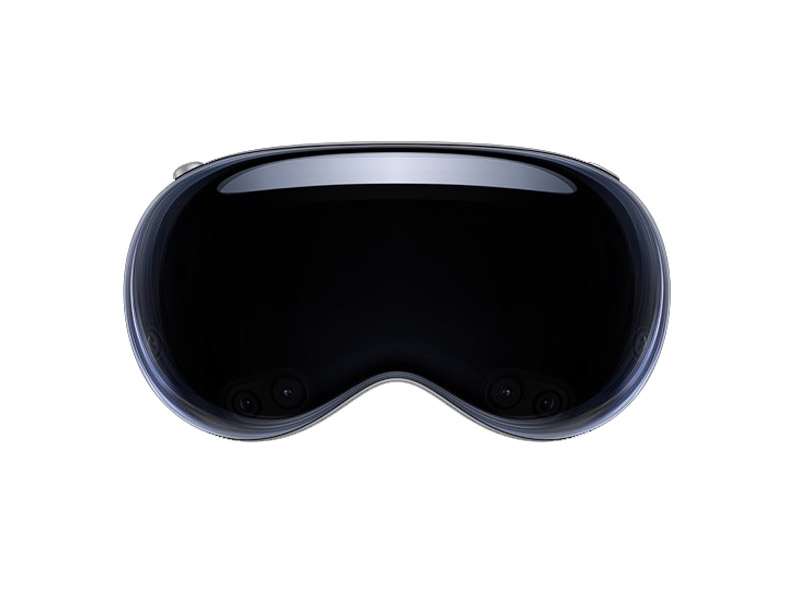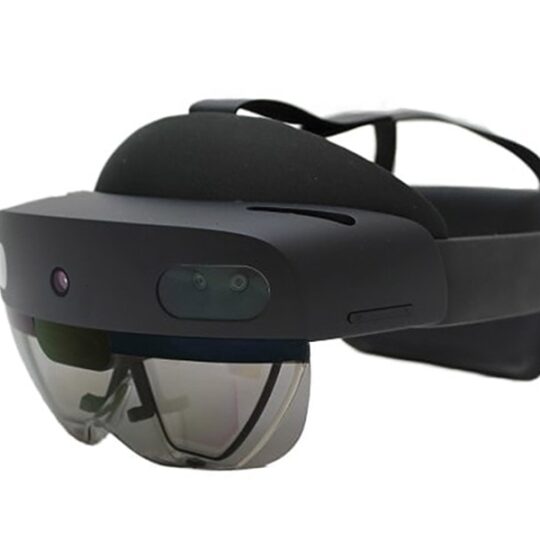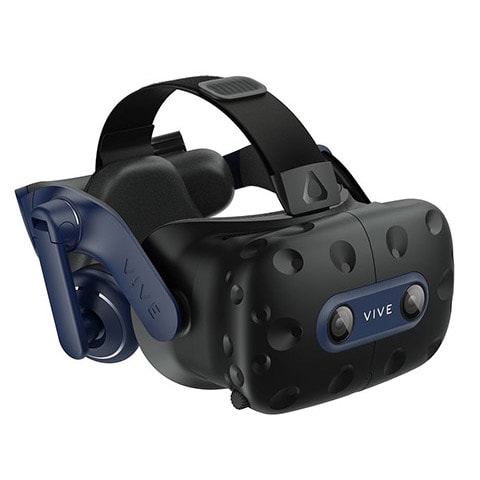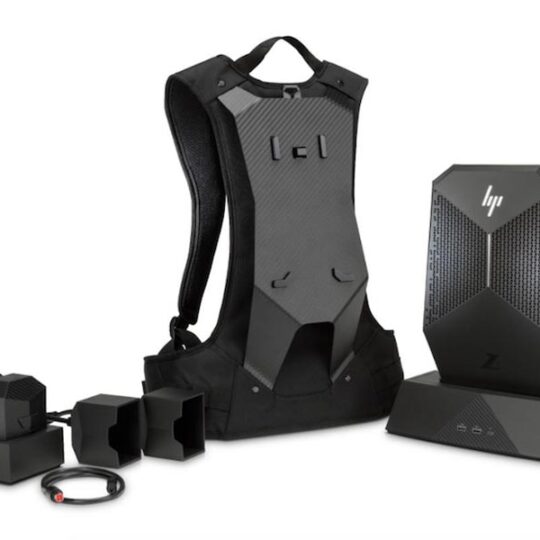
Apple Vision Pro Rental
Be one of the first to rent a Vision Pro headset by submitting your contact info. We’ll notify you the minute you can rent a Vision Pro. All Vision Pro rentals are on a first-come, first-serve basis.
What is the Apple Vision Pro Headset?
The Apple Vision Pro is a mixed reality headset that seamlessly blends digital content with the physical world. It is designed to handle what Apple refers to as “Spatial Computing” and interacts with the physical world around you, keeping you engaged with it as well thanks to its EyeSight feature. The headset is controlled entirely by a user’s eyes, hands, and voice, and features a brand-new three-dimensional user interface and input system.
Apple Vision Pro Headset Specifications
| Processor | Displays | Sensors | Weight | Controls | Battery Pack | OS |
| 1 x M2 chip, 1 x R1 chip | 4K (per eye) | 12 cameras, 6 mics, and 5 sensors | About 1 pound | No controllers but you can connect Bluetooth controllers | 2 hours (with external battery) | VisionOS |
Software
Just about all apps installed on an iPhone will be installed on the Vision Pro. These Apps will run 3D versions and perform similar to how they do on an iPad but updated to take advantage of the mixed reality capabilities. Apps that should be on the headset include:
| Books | Calendars | Camera | Contacts | FaceTime | Fitness |
| Files | Freeform | GarageBand | Home | iMovie | Keynote |
| Maps | Messaging | Notes | Pages | Reminders | |
| Music | News | Numbers | Safari | Stocks | TV |
| Weather |
The Vision Pro headset can be used for select virtual reality tasks, encompassing communication, content viewing and gaming. As the device is not meant to provide an immersive experience akin to extended game play sessions or full-time substitutions of real life experiences, users should take note that they will only enjoy limited VR exposure with the new technology.
Apple is advancing their augmented reality ambitions with the launch of a groundbreaking virtual and augmented reality hybrid headset. This device will provide early access to developers, allowing them enough time to create applications compatible with upcoming releases such as ‘Apple Glass’. The product serves as an important bridge between tech giants’ current vision for AR technology and what may come in the near future.
Release Date
The Apple Vision Pro Release Date is Friday, February 2, 2024, at all U.S. Apple Store locations and the U.S. Apple Store online.
Cost
The Apple Vision Pro will cost $3,499 when it goes on sale in early 2024. That makes it the most expensive consumer-facing headset among the mainstream headsets before you account for accessories or custom Zeiss optical inserts for those who need glasses. HTR has planned ahead in order to grant more users access by offering Apple Vision Pro headset rentals as soon as it becomes available! Our Apple Vision Pro rental terms will range from 1 day up to 12 months.
Reserve Your Apple Vision Pro Rental Spot Today
Based on reports of availability, we are expecting big demand in wanting to try out the headset. Want to be one of the first to rent a Vision Pro headset? Fill out the form below and we’ll contact you as soon as our Vision Pro rental program is available. We’ll be handling requests on a first-come, first-serve basis.
Notify Me:
Gaming
Gaming on the Apple Vision Pro looks promising. Apple has announced that more than 600 new apps and games are being readied for the Vision Pro ahead of its debut. These join the more than 1 million already compatible apps across iOS and iPadOS, the company says. The news comes on the heels of Apple’s proposed compliance plan with the EU’s new regulation, the Digital Markets Act (DMA), which forces Apple to level the playing field by opening up to alternative app stores and payments.
Apple Vision Pro vs The Competition
The Apple Vision Pro is a true mixed reality headset that is designed to handle what Apple refers to as “Spatial Computing.” It interacts with the physical world around you and keeps you engaged with it as well thanks to its EyeSight feature. Unlike most other headsets, you do not need external controllers to interact with the Apple Vision Pro. Instead, it relies on fingers and hand gestures to navigate menus, pinch and zoom images, and more. The headset does support a magic keyboard and magic trackpad for productivity. The Vision Pro has a smaller design, superior passthrough, microOLED display, and two integrated processors.
| Apple Vision Pro | Microsoft HoloLens 2 | Magic Leap | Oculus Meta Quest Pro | Oculus Meta Quest 3 | |
| Price | $3,499 | $3,500 | $2,295 | $999 | $499 |
| Processor | 1 x M2 chip, 1 x R1 chip | Qualcomm Snapdragon 850 | Nvidia Parker SOC chipset1 | Qualcomm Snapdragon XR2 Gen 2 | Qualcomm Snapdragon XR2 Gen 2 |
| Display | 4K per eye | 2K per eye | 1280 x 960 per eye | 1832 x 1920 per eye | 2064 x 2208 per eye |
| Battery | 2 hours | 3 hours | 3 hours | 2.5 hours | 2.9 hours |
| Weight | ~ 1 lbs | 1.3 lbs | 0.83 lbs | 1.83 lbs | 1.13 lbs |
| Target Use | Spatial Computing | AR / VR Immersion | Immersive VR / Gaming | Immersive VR / Gaming | Immersive VR / Gaming |
What is Spatial Computing
Spatial computing is a technology that enables computers to blend in with the physical world in a natural way. It is an umbrella term that encompasses concepts like virtual reality (VR) and augmented reality (AR), as well as the related concepts mixed reality and extended reality. Spatial computing brings together the virtual and physical worlds in a seamless way. You can experience it through headsets such as the Apple Vision Pro, Microsoft HoloLens, Meta Quest Pro, and Magic Leap.
These devices display the real world and, at the same time, embed real objects into the scene in a way that appears three-dimensional. For example, you could place a virtual piece of furniture in your living room to see what it would look like before you buy it; or factory workers can overlay technical manuals onto machine they’re building.
These devices rely on several technologies to mix the digital and physical worlds. They use computer vision, which processes data from cameras and other sensors and captures visual information about the environment, including the position, orientation, and movement of objects. With sensor fusion, they can combine data from multiple sensors, such as cameras and LiDARs, to create an accurate and comprehensive view of the environment. And they use spatial mapping to create a 3D model of the environment, which allows for more precise placement and manipulation of digital content.
One of the key advantages of spatial computing is its ability to understand the depth of the environment. This allows for realistic and natural interactions with virtual objects, because they can be placed and manipulated in a way that corresponds to the physical world. For example, a virtual object can be placed on a table, moved around, or hidden behind other objects in a way that mirrors our real-world actions. Spatial-computing devices have features that enable you to interact with virtual objects. Eye-tracking technology monitors your gaze, and handheld controllers and motion sensors enable you to manipulate virtual objects. For example, the Apple Vision Pro has an advanced eye-tracking system and hand-gesture-detection sensors that let you simply look at items to activate them, or to move them around by pinching your fingers or flicking your wrist. Devices that employ spatial computing might also have speech-recognition features to support voice commands. These are especially useful within hands-on environments such as manufacturing, where you can’t use hand gestures or controllers.




